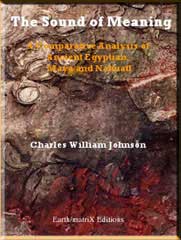 SCIENCE IN ANCIENT ARTWORK AND SCIENCE TODAY In this essay, we shall present further examples of word-concepts and (hiero) glyphs between the ancient maya system of Meso-America and the ancient Egyptian language. For our source material, we shall simply limit the comparison to word-concepts found in Linda Schele and Petter Mathew's book, The Code of Kings (Scribner, 1998), and selected corresponding word-concepts found in E.A. Wallis Budge's two volumes, An Egyptian Hieroglyphic Dictionary (Dover, 1978). In previous essays, we have illustrated the extensive similarity between ancient Egyptian and the maya system, with some comparisons to the Nahuatl language. As we review material that proposes an interpretation of the maya system, it becomes obvious that many more similarities between maya and ancient Egyptian come to light. As we have mentioned earlier, if only one of the many examples that we have offered were to have been related in origin in the past, then one might conclude that some kind of contact existed between these two ancient cultures. It is our understanding, that the tremendous similarity between ancient Egyptian and the maya system, as well as the similarity between ancient Egyptian and Nahuatl (not to be examined here), suggests the existence of a proto-language from which these evolved. They may have been sons and daughters of the same proto-language or, one of them may have in fact served as an origin for the others. The historical record is mute on this point, and we are limited to examining superficial, but convincing, similarities among the ancient languages. Many scholars suggest the existence of a past relationship among these ancient languages, yet, comparative philology is often rejected. For, similarities and coincidences of sound, meaning and symbol are often perceived as being that: merely similarities and coincidences. However, the coincidences of sound, meaning and symbols that we have found between these two languages, in our mind, suggest the possibility that many aspects of these two languages share a common origin. Many examples exist that reinforce this perception. But, consider the word-concept identified by Schele for infant sacrifice known as "k'ex" or "substitution (p.84), and Budge's "substitute in a death ceremony" ---"teknu, tekennu" (846a). Such linguistic correspondence appears overwhelmingly convincing to us. We shall present some of the outstanding examples of linguistic correspondence between the maya system and ancient Egyptian, that we have encountered in our studies in this brief essay... Read more: johnson@earthmatrix.com ©2001-2011 by Charles William Johnson, Earth/matriX. www.earthmatrix.com |

